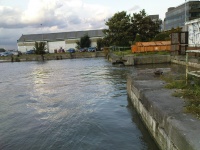Dutch language
From The Art and Popular Culture Encyclopedia

Photo: Antwerp quays in the South of Antwerp, at the former Zuidersluis
|
Related e |
|
Featured: |
Dutch is a West Germanic language spoken by around 23 million people, mainly in the Netherlands, Belgium and Suriname, but also by smaller groups of speakers in parts of France, Germany and several former Dutch colonies. It is closely related to other West Germanic languages (ie. English, Frisian and German) and (to a lesser degree) also the North Germanic languages. Dutch is a descendant of Old Frankish and is the parent language of Afrikaans, one of the official languages of South Africa. Dutch and Afrikaans are to a large extent mutually intelligible, although they have separate spelling standards and dictionaries and have separate language regulators. Standard Dutch (Standaardnederlands) is the standard language of the major Dutch speaking-areas and is regulated by the Nederlandse Taalunie ("Dutch Language Union").
Dutch grammar also shares many traits with German, but has a less complicated morphology caused by deflexion, which puts it closer to English. Dutch has officially three genders, masculine, feminine, and neuter, however, according to some interpretations these are reduced to only two, common and neuter, which is similar to the gender systems of most Continental Scandinavian languages.
The consonant system of Dutch did not undergo the High German consonant shift and has more in common with how English and the Scandinavian languages, especially Swedish and Norwegian, are pronounced. Like most Germanic languages it has a syllable structure that allows fairly complex consonant clusters. Dutch is often noted for the prominent use of velar fricatives (pronounced at the back of the mouth), often picked up on as a source of amusement or even satire.
Dutch vocabulary is predominantly Germanic in origin, considerably more so than English. This is to a large part due to the heavy influence of Norman French on English, and to Dutch patterns of word formation, such as the tendency to form long and sometimes very complicated compound nouns, being more similar to those of German and the Scandinavian languages.
One of the major dialect groups of Dutch, Flemish, is spoken in the southwestern Netherlands and the northwestern part of Belgium. The whole of Dutch variants spoken in Belgium is also often called "Flemish" and sometimes claimed to be a separate language, an issue which can be very controversial for the Dutch-speaking population of Belgium. Officially, both Belgium and the Netherlands adhere to Standard Dutch. The difference between Belgian and Netherlandic Dutch is roughly comparable to the difference between American and British English, though only pronunciation-wise as both countries use the same written standard.
See also
- Vergeten boeken, Literaire curiosa en rarioria, boekenvrienden en bibliomanen (1986, W&L Boeken) is a book by Ed Schilders.

